Bearings play a crucial role in the aviation industry, serving as fundamental components in numerous aircraft systems. Their primary function is to facilitate motion and support mechanical loads, ensuring the smooth operation of various moving parts. Among the different types of bearings used in aviation, the slewing ring bearing stands out for its unique capabilities and applications.
Aircraft are complex machines that demand the highest levels of precision and reliability from each component. Bearings in aviation are specially designed to withstand extreme conditions such as high speeds, heavy loads, and temperature fluctuations. They are integral to the operation of engines, landing gear, control systems, and other critical aircraft parts.
Slewing ring bearings, also known as turntable bearings, are a specific type of bearing that accommodate axial, radial, and moment loads. These bearings are distinguished by their large size and their ability to support heavy loads while enabling rotational movement. The design of slewing ring bearings includes a rotating ring and a stationary ring, which are connected by rolling elements such as balls or rollers. This configuration allows for the bearing to rotate smoothly while supporting substantial loads.
In the aviation sector, slewing ring bearings are essential in areas where large, slow-turning loads need to be supported. One of the most common applications is in the rotary systems of helicopters. The slewing ring bearing in a helicopter’s rotor system enables the rotor blades to spin while supporting the weight of the rotor assembly and withstanding the dynamic loads generated during flight. The reliability and performance of these bearings are critical for the safe operation of the aircraft.

Another application of slewing ring bearings in aviation is in jet engines. These bearings are used to support the weight of the engine components while allowing for the necessary rotational movement. Their ability to handle heavy loads and high speeds makes them ideal for this application. The precision and durability of slewing ring bearings contribute to the efficiency and longevity of jet engines, which are central to an aircraft’s performance.
Maintaining these bearings is a crucial aspect of aircraft maintenance. Regular inspections and maintenance ensure that bearings, including slewing ring bearings, function correctly and safely. Any signs of wear, corrosion, or damage can significantly impact the performance and safety of the aircraft. Maintenance procedures typically involve cleaning, lubricating, and checking for any signs of wear or damage.
The manufacturing process of bearings for aviation, especially slewing ring bearings, is stringent and follows high-quality standards. The materials used must be of high quality to withstand the demanding conditions of aviation. The production process involves precise machining and rigorous testing to ensure that each bearing meets the required specifications and performance criteria.
In summary, bearings, and particularly slewing ring bearings, are indispensable in the aviation industry. They play a pivotal role in the operation and safety of aircraft by enabling smooth motion and supporting heavy loads. The design, manufacturing, and maintenance of these bearings are critical to their performance and the overall safety and efficiency of aviation operations.
For more detailed information on slewing ring bearings, you can visit Zenith Und, which provides comprehensive insights into their design, applications, and importance in various industries, including aviation.